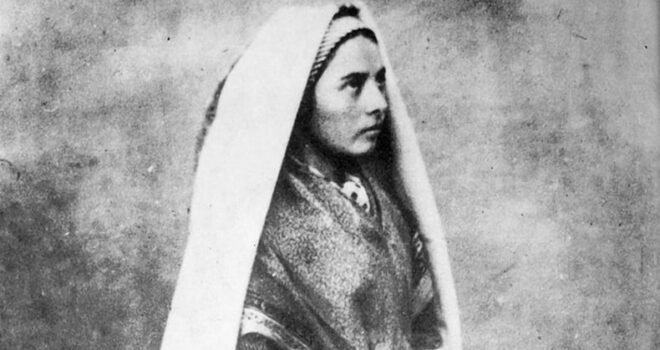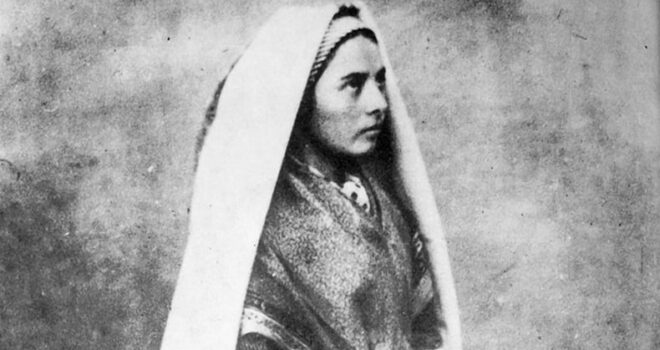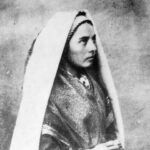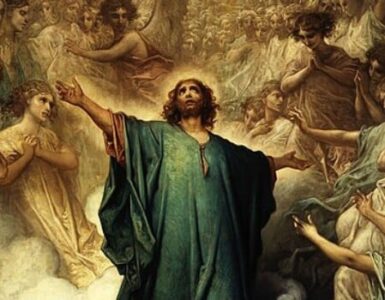Saint Bernadette Soubirous is known for having had visions of the Blessed Mother and the grotto of Massabielle in Lourdes. She should also be known for the holiness of her life. From her childhood until her death at age thirty-five, Saint Bernadette underwent much suffering, caused by poverty, sickness, and the unkindness of some people. She endured her trials with patience and always maintained great faith and hope in God.
Marie Bernarde Soubirous (who was called Bernadette) was born in Lourdes, France on January 7, 1844, the oldest of eight children. Four of her siblings died while still infants. Bernadette’s father had been a miller, but lost his business, and her family was very poor. They lived in a one room basement apartment in a former jail. Bernadette helped to take care of her younger brothers and sister and did not receive any education until she was fourteen years old, when she began attending a school in Lourdes administered by the Sisters of Charity and Christian Instruction. At that time, she also received instruction from a priest in preparation for her First Holy Communion. Bernadette had poor health, suffering from asthma. She was also very small in size, only four feet, four inches tall. Despite poverty and illness, Bernadette had a cheerful personality and a good sense of humor.
Bernadette’s life was changed completely on February 11, 1858, the day she saw the Blessed Mother for the first time at the grotto. Bernadette, her sister, and a friend had gone to gather wood for Bernadette’s mother. The other girls crossed the stream ahead of her, and as she was removing her shoes and stockings, she heard a noise. She looked up and saw a young woman, “exceedingly beautiful”, wearing a white dress, with a blue sash, a white veil, and carrying a Rosary with white beads. Bernadette immediately knelt and took out her Rosary and was about to make the sign of the cross, but discovered, “My arm could not move until the Lady herself made a beautiful sign of the cross.” While Bernadette prayed the Rosary, the Lady followed along on the beads but did not say the words of the prayers. This vision of the beautiful young woman brought Bernadette great joy. She told her sister what she saw, but that night when her sister told their parents, they did not immediately believe that Bernadette saw the Lady. However, they allowed her to return to the grotto three days later where Bernadette saw the Lady again. During her third appearance, the Lady asked Bernadette if she would go to the grotto for fifteen days and told her, “I do not promise to make you happy in this life, but in the next.” She also requested that Bernadette tell the priests to have a chapel built there. Because of this request, Bernadette went to see the parish priest, Father Peyramale. He was skeptical of the visions and asked Bernadette to find out the Lady’s name. Bernadette did not know her name and only referred to her as the Lady or Aquero, which meant “that one” in her native dialect. Bernadette continued to have beautiful experiences each time the Lady appeared to her. In one of her apparitions, the Lady taught Bernadette a special prayer, which she never told anyone. In another apparition, the Lady told Bernadette three secrets, which she said made her remain “prayerful, grateful, humble.” The Lady requested that Bernadette pray for sinners, and in her eighth apparition, the Lady said, “repentance, repentance, repentance.”
In her ninth appearance to Bernadette, on February 25, 1858, the Lady told her to drink from the spring and wash in it. There was no visible spring and so the Lady directed her to a muddy area beneath the rock, which later that day turned into a great spring of pure water. On March 25, 1858, the Feast of the Annunciation, the Lady finally revealed her identity. She said to Bernadette, “I am the Immaculate Conception.” Bernadette did not know what that meant, but repeated the words to herself on the way from the grotto in order to remember them to tell Father Peyramale. When she told him what the Lady had said, he realized that she was the Blessed Mother. He became a great supporter of Bernadette and her visions, and later raised money to have a basilica built at the grotto. Bernadette asked a woman she knew about the meaning of the Immaculate Conception. She said, “It was then I realized I could speak what was unspoken in my soul for seven silent weeks– that Aquero was the Immaculate Virgin Mary. She was the Mother of God, and she had been stepping out of Heaven to share her soul with me. She taught me prayers no soul on earth had prayed. She had promised me happiness, not in this world, but in the next.” Many people in the town, too, already believed that the Lady appearing to Bernadette was Mary. Miracles began to happen. For example, a man regained vision in his eye and a two year old child who was dying, was healed, after being immersed in the spring of water.
Bernadette received her First Holy Communion on the Feast of Corpus Christi. It was a very joyful day for her, a day she had been waiting for. She realized, “My soul has been prepared for Jesus by his Mother and my faith became enlightened in Communion with my God.”
Bernadette saw the Blessed Mother at the grotto for the last time on the feast of Our Lady of Mount Carmel. Although the eighteen apparitions of the Blessed Mother gave Bernadette great inner peace, she did not experience peace in her town as she underwent interrogations by the police and government officials, was threatened with being sent to jail, was questioned by Church leaders, and was often pursued by strangers who wanted to meet her and request her autograph.
To avoid further harassment by the government officials, Father Peyramale arranged for Bernadette to stay with the sisters in the convent, where she continued her education and assisted in their kitchen.
On January 18, 1862, the Bishop of Lourdes declared the apparitions of the Blessed mother to Bernadette to be authentic. Lourdes became a place of pilgrimage, healing, and conversion.
When Bernadette was twenty-one years old, the Bishop visited her and asked if she had considered getting married. When she said no, he asked if she had thought of becoming a sister. He told her to pray about it and to contact him if her heart said yes to that vocation. Bernadette decided to join the order of the sisters who had instructed her, and left Lourdes to enter the convent in Nevers, in July 1866. She never returned to Lourdes. Her name in religious life was Sister Marie Benard, her baptismal name.
On the day of Bernadette’s profession, the Mother General told the Bishop in Bernadette’s presence, that she didn’t know where to assign her. She said, “She is a little stupid, and is good for nothing.” Unfortunately, that seemed to have been the attitude of Bernadette’s superiors, including her former teacher who became her novice mistress. Despite the obstacles caused by her superiors, God provided Bernadette the opportunity to use her gifts and talents. The Bishop gave her the assignment of praying. She worked in the infirmary for six years where she was able to bring consolation to the sisters who were sick, and then worked in the sacristy for almost two years, and demonstrated great talent in the embroidery of vestments. When she could no longer work because she was very ill with tuberculosis and in severe pain, she said, “My job is to be sick.” She understood that suffering was part of her vocation.
Although we clearly can see the injustice of Bernadette’s superiors behaving toward her with harshness and unkindness, Bernadette did not display any anger or resentment to them. Instead, she practiced the spiritual works of mercy of forgiveness and bearing wrongs patiently.
Because of Bernadette’s humility, she was not overly sensitive about herself. For example, when a new young woman joined the convent, she asked to see Bernadette. When one sister said that Bernadette was standing right next to her, the woman responded, “only that?” Bernadette did not become insulted, but went over to the woman, shook her hand, and said, “Yes, Mademoiselle, just that,” and they became good friends.
April 16, 1879, Easter Wednesday, was Bernadette’s last day on earth. Before Bernadette died, she said, “My God, I love you with all my heart, with all my soul, and with all my strength.” She held a crucifix and kissed it. Then she said that she was thirsty, made the sign of the cross, drank a little water, and died peacefully while saying her last words, “Holy Mary, Mother of God, pray for me, a poor sinner, a poor sinner.”
Bernadette was declared venerable in August 1913, beatified in June 1925 and canonized as a saint on December 8, 1933.
Although we cannot know for certain why the Blessed Mother chose to appear to Saint Bernadette, it seems appropriate that she did, as Bernadette was a girl of great faith, who knew about suffering, was obedient to God, was willing to pray for sinners, and demonstrated great love for God, Mary, and other people.
Saint Bernadette had a simple spirituality that anyone can practice in every state of life. She accepted the sufferings of her life and offered them up to God, she was dedicated to praying the Rosary, to doing the duties assigned to her out of love for God, and adored Jesus in the Blessed Sacrament. This quotation exemplifies her spirituality. “I must I die to myself continually and accept trials without complaining. I work, I suffer and I love with no other witness then his heart. Anyone who is not prepared to suffer all for the Beloved and to do his will in all things is not worthy of the sweet name of Friend, for here below, Love without suffering does not exist.”













